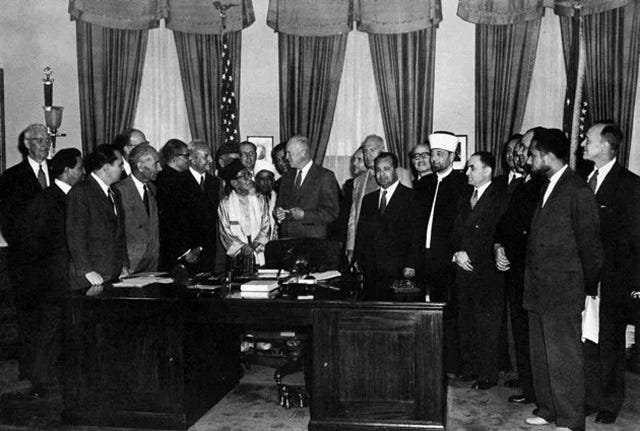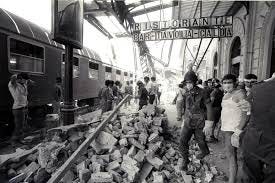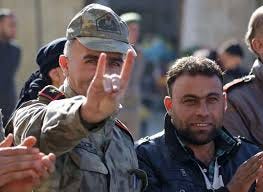The Fall of Assad: Another CIA Overthrow
Syria’s regime bears all the hallmarks of Operation Gladio. See the historical parallels, media manipulation, and ties to Western intelligence.
What Is Operation Gladio, and Why Does It Matter?
Imagine a hidden hand pulling the strings of world politics—a secret operation designed to control narratives, topple governments, and rewrite the rulebook.
That’s Operation Gladio for you.
Born during the Cold War, Gladio wasn’t just another hush-hush NATO project. It was a playbook of false flags, media manipulation, assassinations, and support for extremist groups, all wrapped in the guise of fighting communism.
Think about Italy in the 1980s. The Bologna train station bombing was pinned on leftist radicals—except, it wasn’t them. It was a false flag operation to delegitimize the left.
Or Turkey, where anti-communist militias (the Grey Wolves) sowed chaos to justify cracking down on political opposition. These events weren’t random—they were part of a grand strategy to shape geopolitics from the shadows.
Syria: A Country Caught in the Crossfire
Now let’s talk about Syria, a nation that seems perpetually stuck in the eye of the storm.
Bashar al-Assad and his father, Hafez al-Assad, have ruled Syria for over five decades, shaping the nation's politics, economy, and international relationships. While they share some similarities in governance, their approaches, circumstances, and the global contexts they operated in reveal notable differences.
Hafez al-Assad: The Architect of Modern Syria
Hafez al-Assad came to power in 1970 through a military coup, often referred to as the Corrective Revolution. They overthrew Salah Jadid, who was by all accounts a radical socialist.
Government owned the major industries. Redistribution of land. Expanded state control. Sounds pretty textbook.
So Hafez overthrew Jadid, establishing a long-lasting Ba’athist regime. Hafez’s government was characterized in CIA documents as a “republic, under leftwing military regime since March 1963.” The document further states that communists in the area most sympathizers numbering 5,000 (out of 9.4 million) or about 0.05% of the population.
It also stated that one of the main oppositions to Syria’s government was the Muslim Brotherhood.
Surprise: The Muslim Brother has connections to the CIA.

Said Ramadan (pictured above) was an influential leader within the Muslim Brotherhood and son-in-law of its founder, Hassan al-Banna. He played a pivotal role in establishing the organization's presence in Europe.
In 1958, he took control of the Munich Mosque Construction Commission, aiming to build a significant Islamic center in Munich. During this period, Ramadan received support from the U.S. Central Intelligence Agency (CIA), which funded his travels and facilitated his efforts to assume leadership of the mosque.
Assisting Ramadan was Ali Ghaleb Himmat, a Syrian national born in Damascus in 1938. He co-founded and managed Al Taqwa Bank in 1988 and led the Islamic Community of Germany (IGD) from 1973 to 2002. Himmat was also “accused” of supporting al-Qaida after a 3.5 year investigation. These criminal proceedings were abruptly cancelled by the AG of Switzerland due to legal technicalities.
Plot Twist: Al-Qaida has ties to the CIA too.
So Hafez overthrew Jadid, establishing a long-lasting Ba’athist regime. While the media would paint him as authoritarian and a dictator, the truth, as it often is, is a bit different.
Hafez al-Assad brought relative stability to Syria after a period of political instability marked by coups and factionalism. His leadership ended the frequent changes in government that had plagued the country since independence. He emphasized Syrian nationalism and sought to unify the country’s diverse population, including Sunni Muslims, Alawites, Christians, Druze, and others.
He invested in large-scale infrastructure projects, including dams, roads, and schools. The Tabqa Dam (also known as the Euphrates Dam) was a major achievement, providing hydroelectric power and irrigation for agriculture. He promoted the expansion of heavy industries, which contributed to Syria's economic modernization and reduced dependence on agriculture.
He also expanded access to education, particularly for rural and underprivileged communities.
This is a much different story than what is painted.
His son continued the work.
Bashar al-Assad: The Accidental Leader
When Hafez died in 2000, Bashar al-Assad, a trained ophthalmologist with little political experience, assumed the presidency.
Bashar pursued a reform agenda, liberalizing parts of Syria’s economy to attract foreign investment. He sought to modernize infrastructure, develop tourism, and increase private-sector participation. Under his leadership, Syria entered the digital age. Internet and mobile phone services, which had been minimal under Hafez, became more widely available.
Like his father, Bashar continued to promote a secular government, which many saw as essential in a nation with significant religious and ethnic diversity.
But, he made a mistake.
His government has consistently opposed Western influence in Syria, framing it as a defense of national sovereignty against neo-imperialist agendas.
During the Syrian Civil War (which has been going on since 2011), Bashar’s government has been a major force in fighting ISIS and other extremist groups, often framing his regime as a stabilizing force in a region plagued by jihadist violence.
The Syrian Civil War: Western Intelligence and the Free Syrian Army
The Syrian Civil War, which began in 2011, has become one of the most complex and devastating conflicts of the 21st century. A critical aspect of this conflict has been the Free Syrian Army (FSA) and its connections to Western intelligence agencies and NATO-backed operations.
Formation of the Free Syrian Army
The Free Syrian Army emerged in 2011 as one of the first organized opposition groups to challenge Bashar al-Assad's government. Initially comprised of defectors from the Syrian military, the FSA quickly gained international recognition as a
”moderate” alternative to Assad’s government. It presented itself as a champion of democracy, appealing to Western powers for support.
Western Backing
CIA Involvement: The Central Intelligence Agency (CIA) began funneling arms and funding to the FSA through covert programs like Timber Sycamore, a classified operation initiated during the Obama administration.
Training Programs: The U.S., in collaboration with Turkey, Jordan, and Saudi Arabia, established training camps for FSA fighters. These camps were designed to create a force capable of overthrowing Assad while avoiding direct Western military involvement.
NATO’s Role: NATO countries, particularly Turkey, played a significant role in facilitating the FSA’s operations. Turkey served as a logistical hub, allowing weapons, fighters, and supplies to flow into Syria. NATO intelligence-sharing mechanisms also provided the FSA with strategic advantages.
Co-opted Groups and Fragmentation
As the war progressed, the FSA became increasingly fragmented, and its ranks were infiltrated by other groups with diverging agendas. Western intelligence agencies, eager to counter Assad and his allies (Russia and Iran), often supported groups that aligned temporarily with Western interests but had questionable loyalties.
Islamist Infiltration
Jabhat al-Nusra: This al-Qaeda-affiliated group exploited the FSA’s resources and alliances. Though initially considered a separate entity, it often coordinated operations with the FSA, blurring the lines between “moderate” and “extremist” factions.
ISIS: While the FSA officially opposed ISIS, the chaos created by overlapping allegiances and shared weaponry sometimes led to Western-supplied arms “falling” into the hands of ISIS fighters.
Shift in Western Support
As the FSA lost cohesion, Western intelligence began redirecting support to other factions within Syria. These groups often included Islamist elements, such as Ahrar al-Sham (backed by Turkey) and Faylaq al-Sham (also backed by Turkey), which aligned with NATO-backed efforts against Assad while further fragmenting the opposition.
NATO’s Involvement
NATO’s indirect involvement in the Syrian Civil War extended beyond logistical support to the FSA. Key NATO players pursued their own strategic interests:
Turkey’s Dual Role: As a NATO member (and hub of Operation Gladio), Turkey was a crucial conduit for arms and training for the FSA. However, Turkey’s focus on curbing Kurdish forces in northern Syria often complicated NATO’s goals, leading to conflicts of interest.
European Powers: Nations like France and the UK supported the FSA diplomatically and materially, with an emphasis on promoting a “moderate” opposition to Assad.
Proxy Warfare: NATO’s broader strategy involved leveraging the FSA and other opposition groups as proxies to undermine Assad’s government without committing ground forces, reflecting a continuation of Cold War-era tactics.
So, the Syrian Civil War was (and is) in fact a modern proxy war, where covert operations, intelligence agencies, and alliances maneuver for a common goal.
The overthrow of a government that wants to distance itself from Western influence.
The Free Syrian Army’s connections to Western intelligence and NATO reveal the interplay between local actors and global powers. All the while, the FSA is framed by the media as a legitimate opposition force (Rebels), ignoring their direct ties to Western Intelligence.
Is the Fall of Assad a Gladio-Style Coup?
Fast forward to 2024, and the pieces start falling into place. Damascus has fallen, Assad has fled, and the rebel coalition is calling the shots. But if you dig a little deeper, the fingerprints of a Gladio-style operation aren’t hard to spot.
Think about it.
There’s the media blitz, portraying rebel forces as freedom fighters while painting Assad as the ultimate villain.
Then you’ve got the suspiciously unified rebel factions, like Hayat Tahrir al-Sham (HTS) and the Syrian National Army, groups with wildly different ideologies suddenly working together.
And let’s not ignore the external backing—from Turkey’s strategic interests to Israel’s not-so-subtle moves to weaken Iranian influence.
Does it sound familiar?
It should. It’s the same playbook we’ve seen before, from Chile in 1973 to countless other Gladio-connected operations. When you piece it all together, it’s hard not to wonder: Is this really a grassroots rebellion, or are we watching another chapter in the history of covert regime change?
Add in ALL the connections the “rebels” have to the CIA, NATO, and Turkey…
Why It All Matters
The fall of Assad isn’t just about Syria. It’s a reminder of how power works behind the scenes—where wars aren’t just fought with guns and tanks but with narratives, alliances, and propaganda.
If you’re paying attention, Syria’s story feels less like a standalone event and more like a rerun of tactics we’ve seen before.
History has a funny way of repeating itself, doesn’t it?
Parallels to Operation Gladio (More Proof)
Psychological Warfare and Media Manipulation
State and international media portrayed Assad as a brutal dictator to delegitimize his regime and justify intervention.
Rebel forces used strategic messaging and social media to gain sympathy, with groups like the White Helmets playing a controversial role. The White Helmets was started by James Gustaf Edward Le Mesurier.
Le Mesurier was a British Army officer and worked as part of the UN peacekeeping force in former Yugoslavia. He was also an intelligence officer in Bosnia and Kosovo.
In 2013, with the Turkish NGO AKUT Search and Rescue Association, ARK (for which Mesurier worked) started training non-governmental Syrian civil defense teams in Turkey, funded by the UK, U.S. and Japanese governments and managed by Le Mesurier.
Tactics echo Operation Gladio’s psychological operations, aimed at framing governments as oppressive and rallying public support for intervention.
False Flag Operations
Alleged chemical weapons attacks in Ghouta (2013) and Douma (2018) were widely attributed to Assad but remain contested. One senior U.N. official, citing rebels in Ghouta, stated that “Saudi intelligence was behind the attacks.”
Accusations suggest some opposition groups may have staged incidents to provoke Western military intervention.
These incidents align with Gladio’s false flag tactics, where events were orchestrated to frame adversaries and justify action.
Support for Right-Wing or Islamist Militias
Western intelligence and NATO-backed forces like Hayat Tahrir al-Sham (HTS) and Syrian National Army (SNA) included extremist factions.
Turkey, as a NATO member, provided training and arms to Islamist-leaning groups while pursuing its own regional interests.
This mirrors Gladio’s strategy of supporting ideologically aligned but ethically questionable militias.
Intelligence Agency Involvement
CIA’s Timber Sycamore program armed and trained Syrian rebels, but resources often ended up with extremists.
Speculation surrounds Mossad and other agencies’ involvement, particularly in targeting pro-Assad forces in line with Israeli strategic goals.
Covert operations in Syria reflect Cold War-era tactics, where intelligence agencies played a pivotal role in destabilizing regimes.
Western Geopolitical Interests in Syria
If you’re now wondering “okay, but why Syria? What’s so special about it?”
Just look at it’s location:
Syria borders Israel, Lebanon, Turkey, Iraq, and Jordan, making it a key player in Middle Eastern geopolitics. Its location places it at the heart of regional rivalries and trade routes. Western powers have long eyed Syria as a potential transit hub for gas pipelines, such as the proposed Qatar-Turkey pipeline, which could bypass Russia’s energy monopoly in Europe.
Assad’s alignment with Russia and opposition to this project didn’t sit well with the West.
But, let’s take a step back. Let’s go back to 2016.
By 2016, the Syrian Civil War had become a global flashpoint, exacerbating tensions between the U.S. and Russia. Western governments framed Assad’s government as a humanitarian and political crisis, while Russia and Iran saw his survival as essential to their own strategic goals.
The Obama administration tried to topple the government by both supporting rebel groups while combating ISIS. Programs like Timber Sycamore armed opposition factions. When the “chemical weapons” story came out, the U.S. launched airstrikes against ISIS and Assad’s forces, accusing the regime of using chemical weapons—a claim Russia repeatedly challenged.
The Syrian conflict became a contentious issue in the U.S. presidential race, with candidates Hillary Clinton and Donald Trump presenting starkly different approaches:
Clinton advocated for a no-fly zone over Syria to protect civilians and curb Assad’s air power. She suggested that the U.S. should have taken a stronger “leadership role” in ousting Assad.
Trump, on the other hand, criticized U.S. involvement in Syria, arguing that efforts to remove Assad risked further destabilizing the region and strengthening groups like ISIS. He wanted to focus on defeating ISIS rather than targeting Assad, framing regime change as a costly mistake in line with previous U.S. interventions in Iraq and Libya.
Had Hillary Clinton been elected, the U.S. would likely have taken a more active and aggressive role in Syria, pursuing regime change, no-fly zones, and increased support for opposition forces. While her approach, on the surface, aimed to resolve the conflict and counter Russian and Iranian influence, it carried significant risks of escalation, unintended consequences, and prolonged U.S. involvement in another Middle Eastern war.
But that’s not what happened. Trump was elected in 2016.
Trump defeated ISIS in Syria in 2019 through significant support to Syrian Democratic Forces (SDF), which strangely enough, is opposed by Turkey.
This victory, however, did not stop the “powers that be” of dreaming of control over Syria and its government. Which, it would seem was accomplished with the ousting of Bashar al-Assad.
Implications of the Syrian Regime Change in the Context of Operation Gladio
The fall of Bashar al-Assad’s regime, if analyzed through the lens of Operation Gladio, carries profound implications for Syria and the broader Middle East.
Proxy warfare destabilizes nations, leaving power vacuums that are often filled by extremist groups or foreign-controlled factions (CIA, NATO, Etc). In Syria, the absence of a unified opposition will likely lead to prolonged chaos and the emergence of radical actors.
Destabilized regions also become geopolitical chessboards where foreign actors exert influence, as seen in Gladio operations across Europe during the Cold War.
The regime change also echoes the other goals/outcomes of Operation Gladio and the West’s interventions in the east:
Weakening Russia-aligned states
The use of media for psychological warfare. This would shape the regime change appear as a moral imperative rather than a strategic calculation.
Because the region will be destabilized, the west will establish bases to help “stabilize the region.” This will include a litany of NGOs, military presence, and the like.
Any new regime is also likely to rely on support from Western powers or regional actors like Turkey, diminishing Syria’s ability to act independently.
Fragmentation of Territory: Ongoing conflicts over Kurdish autonomy and Turkish-controlled regions suggest a divided Syria, reducing its national integrity.
Assad’s fall shifts the regional balance, weakening the Iran-Syria-Hezbollah alliance while bolstering Sunni-majority Gulf states and Turkey.
The Syrian regime change mirrors many tactics and consequences of Operation Gladio, from proxy warfare and media manipulation to the erosion of sovereignty and the rise of extremism.
While the fall of Assad might align with Western strategic goals, it also risks plunging Syria into prolonged instability, deepening regional rivalries, and leaving a legacy of devastation reminiscent of Gladio’s destabilizing operations.
These parallels suggest that the conflict in Syria is not just a civil war but a calculated chapter in a larger geopolitical playbook.








Hi White Rabbit, my maternal grandfather fled Syria at the turn of the century to escape the Turks indenturing young fighting age Syrians. So Im half Syrian and it has made me sick to witness the fall of Syria to Islamic radicals and yes, thru hand of the evil See Eye A.
While I have not ever read an account of truth and deep insight like yours here, I always knew instinctively in my gut, heart and soul, the events leading to the fall of Bashar Assad who now resides inside Russia, have been EXACTLY as you portray, including the part about Chemical weapons.
Its so fricking sad to know of the total destruction of the country that my ancestors dwelled and as the story goes, Jesus also spent much of his life there.
I want to thank you for the exposure you bring to the forefront - and all of the time spent gathering this data.
My Syrian heritage stems from the Christian Orthodox Church - so its a double gut punch to know the Islamic Radicals - now control it.
But thats the way the wheels turn and I despise the evil CIA, George Wilhelm Bush And all his misdeeds along with pals like Hillary Clinton.
Thank you for an outstanding article. 🇺🇸🍻
I listen to all your substacks when the option is available....why are they not all read aloud enabled ?